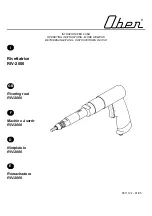
4- ENG
D26409
• Tools which cut, shear, drill, staple, punch, chisel, etc.
are capable of causing serious injury.
• Tools which contain moving elements, or drive other mov-
ing tools, such as grinding wheels, sockets, sanding discs,
etc. can become entangled in hair, clothing, jewelry and
other loose objects, resulting in severe injury.
• Never wear loose fitting clothes, or apparel which
contains loose straps or ties, etc. which could become
entangled in moving parts of the tool.
• Remove any jewelry, watches, identifications, bracelets,
necklaces, etc. which might become caught by the
tool.
• Keep hands away from moving parts. Tie up or cover
long hair.
• Always wear proper fitting clothing and other safety
equipment when using this tool.
• Keep the working part of the tool away from hands and
body.
HAZARD
WHAT COULD HAPPEN
HOW TO PREVENT IT
RISK OF ENTANGLEMENT
HAZARD
WHAT COULD HAPPEN
HOW TO PREVENT IT
RISK OF CUT OR BURNS
• Improperly maintained tools and accessories can cause
serious injury.
Use only accessories identified by the manufacturer to
be used with specific tools.
• Use of an accessory not intended for use with the
specific tools, increases the risk of injury to persons.
• Maintain the tool with care.
• Keep a cutting tool sharp and clean. A properly
maintained tool, with sharp cutting edges reduces the
risk of binding and is easier to control.
HAZARD
WHAT COULD HAPPEN
HOW TO PREVENT IT
RISK OF INJURY (continued)
• Using air tools to attach electrical wiring can result in
electrocution or death.
• Never use nailer/staplers to attach electrical wiring
while energized.
• Avoid body contact with grounded surfaces such as
pipes, radiators, ranges, and refrigerators. There is an
increased risk of electric shock if your body is
grounded.
• Fasteners coming in contact with hidden electrical
wiring could cause electrocution or death.
• This tool is not provided with an insulated gripping
surface. Contact with a “live” wire will also make
exposed metal parts of the tool “live” and can result in
electrocution or death.
HAZARD
WHAT COULD HAPPEN
HOW TO PREVENT IT
RISK OF ELETRIC SHOCK
• Thoroughly investigate the workpiece for possible
hidden wiring before performing work.
• Check for misalignment of binding or moving parts,
breakage of parts, and any other condition that affects
the tool’s operation. If damaged, have the tool serviced
before using.
• There is a risk of bursting if the tool is damaged.






























